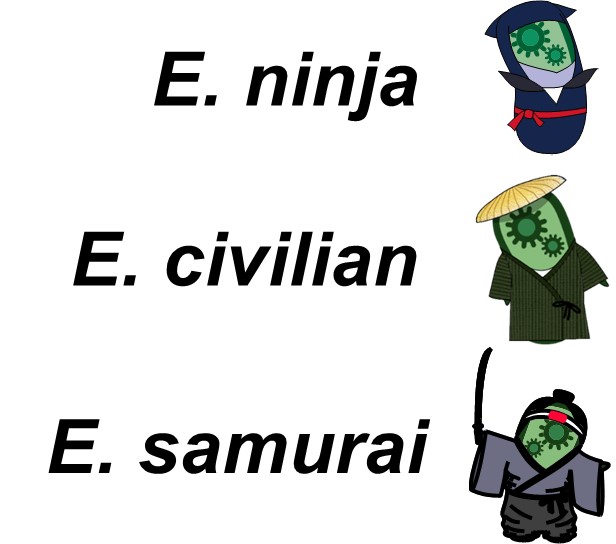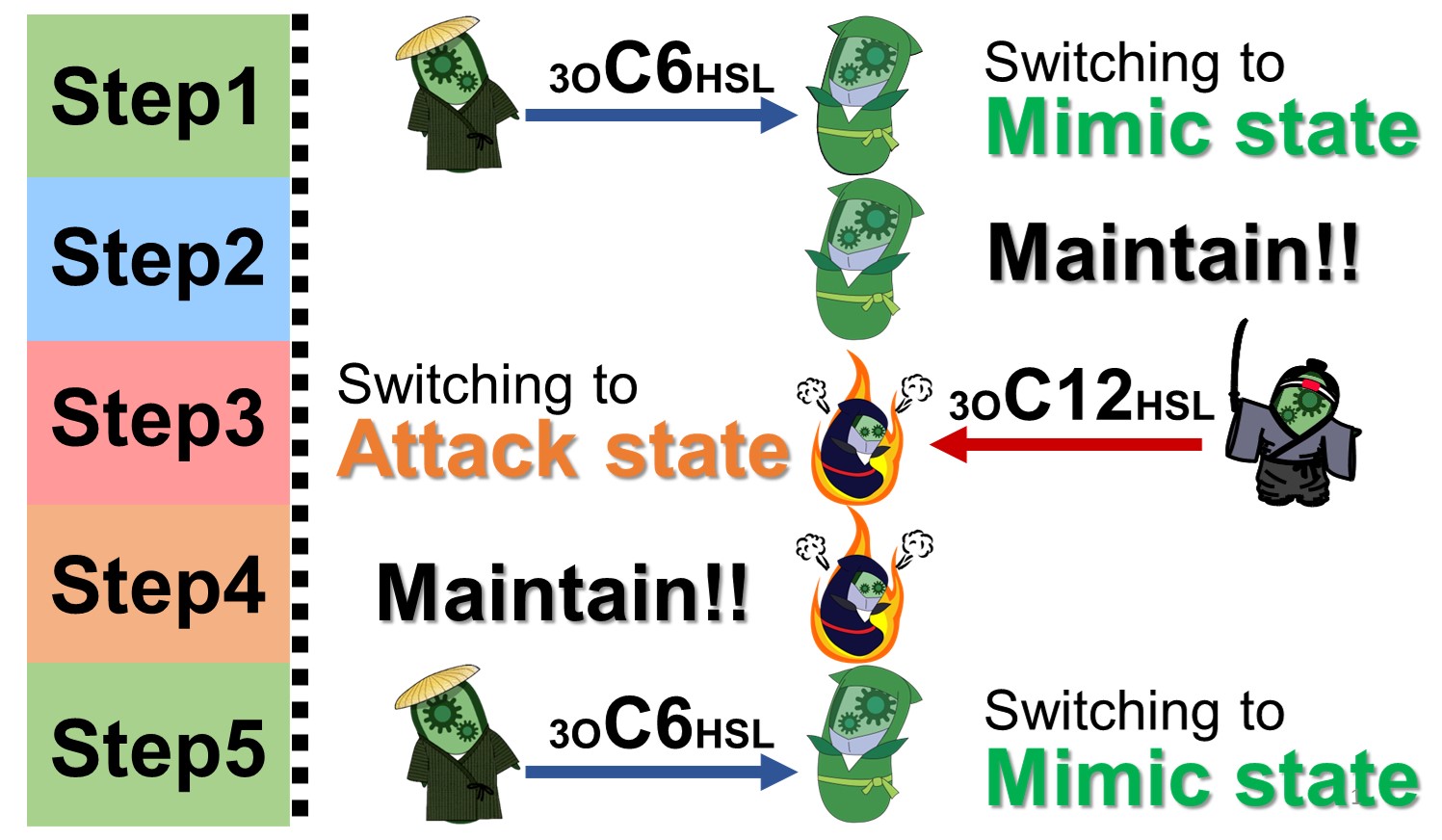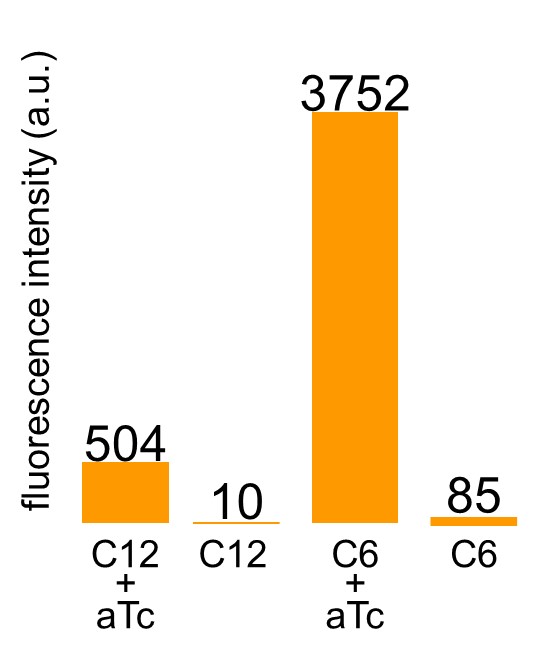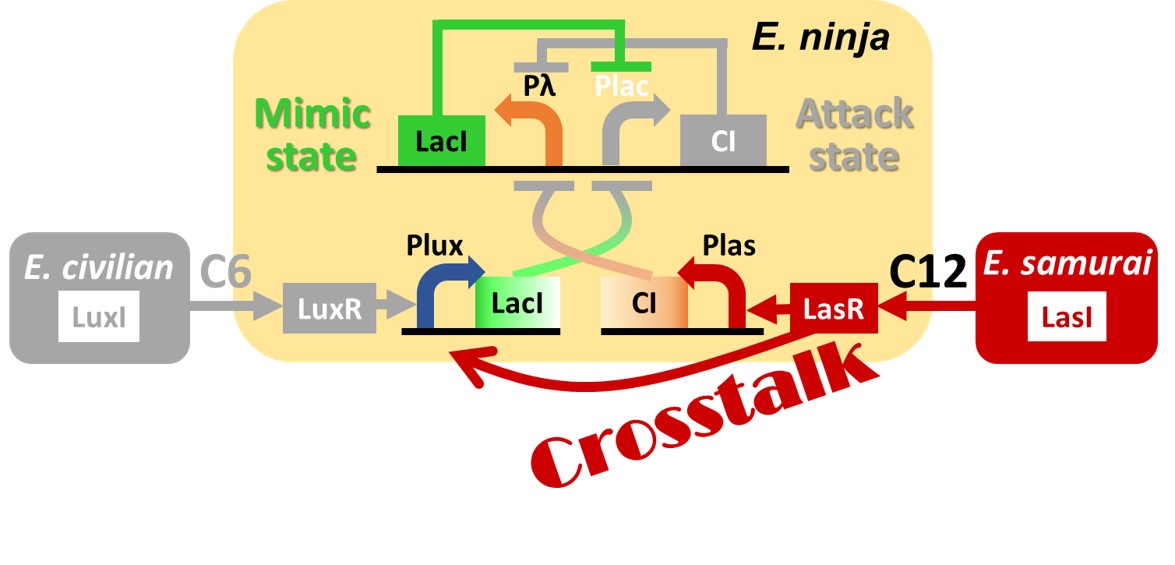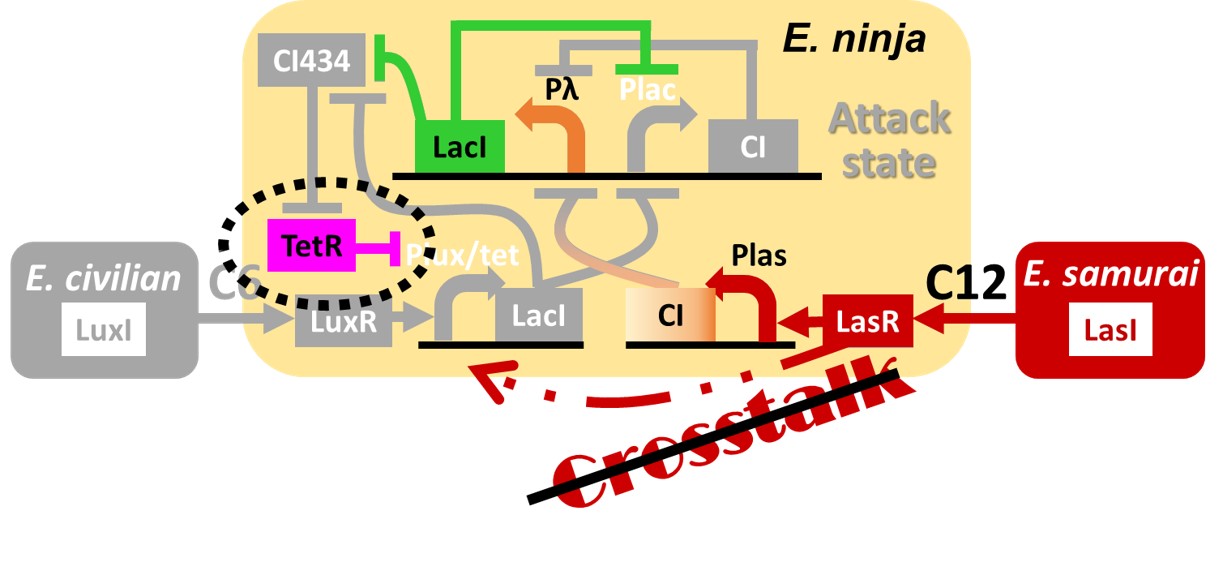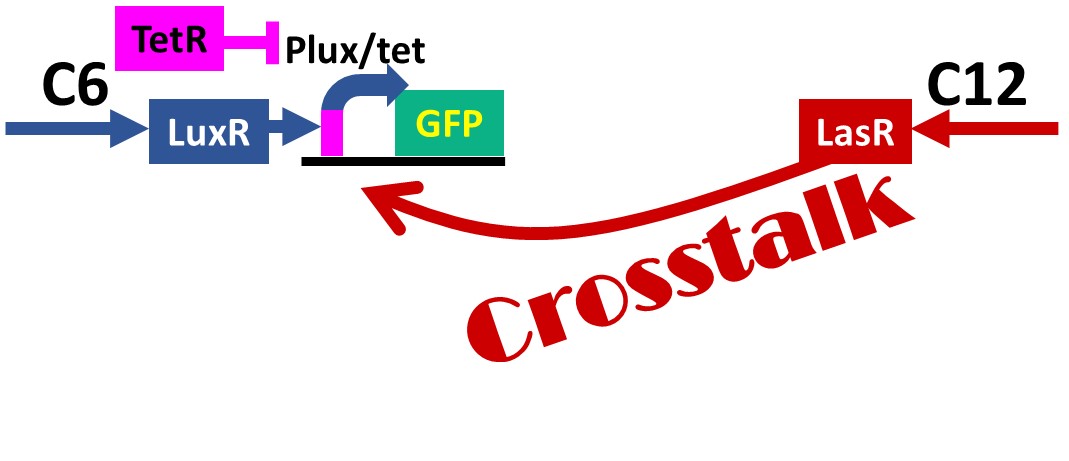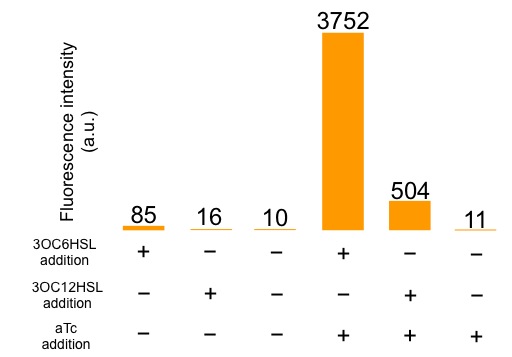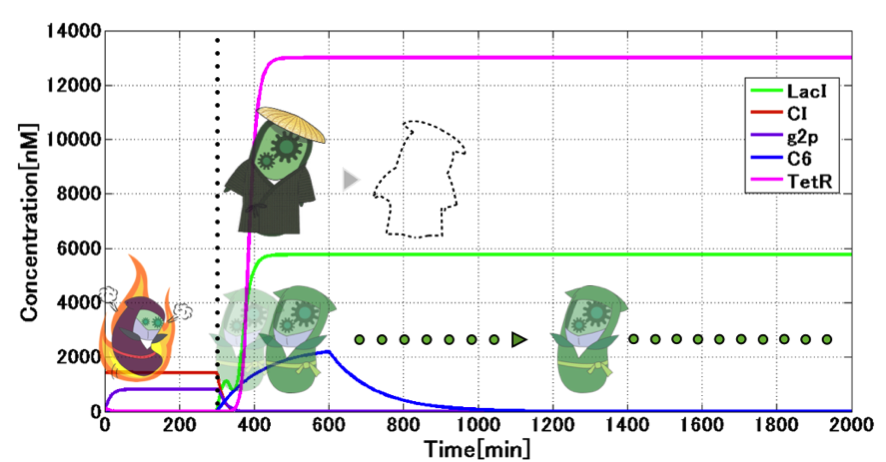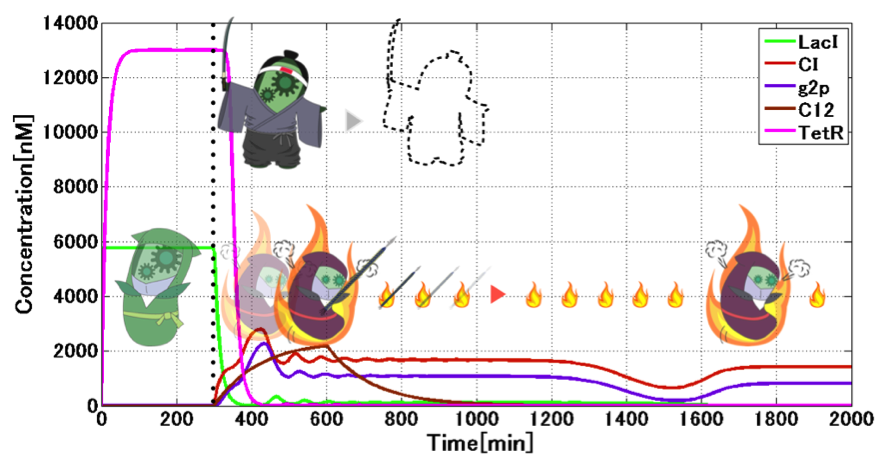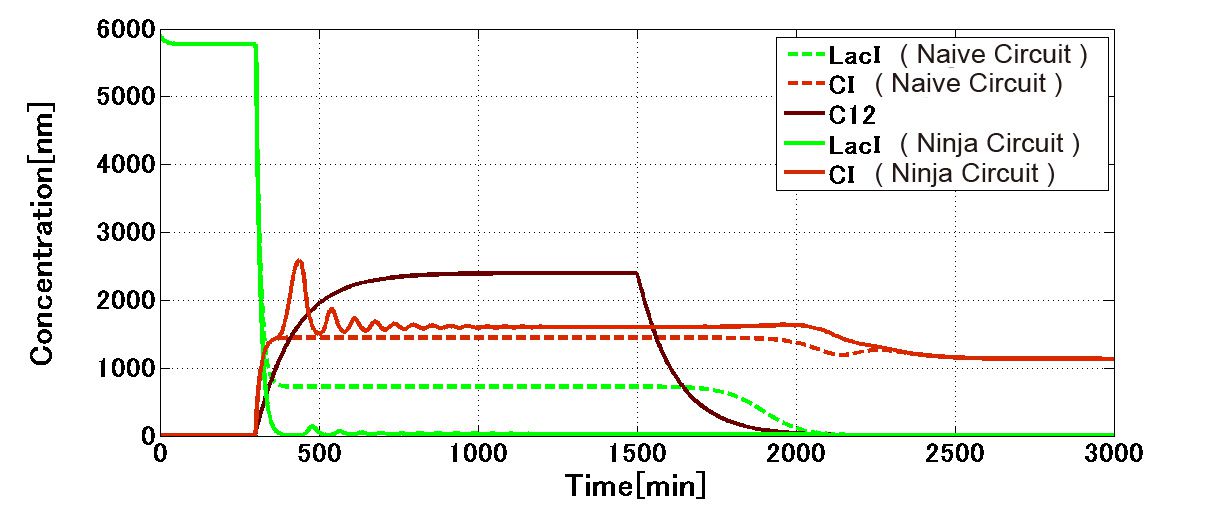Team:Tokyo Tech/Project/Ninja State Switching
From 2013.igem.org
| Line 85: | Line 85: | ||
<h3>Construction</h3> | <h3>Construction</h3> | ||
<h2> | <h2> | ||
| - | [[Titech2013_Ninja_State_Switching_2-1_3-2_regulatorplasmid.jpg|500px|frameless|center]] | + | [[Image:Titech2013_Ninja_State_Switching_2-1_3-2_regulatorplasmid.jpg|500px|frameless|center]] |
| - | [[Titech2013_Ninja_State_Switching_2-1_3-2_reporterplasmid.jpg|500px|frameless|center]] | + | [[Image:Titech2013_Ninja_State_Switching_2-1_3-2_reporterplasmid.jpg|500px|frameless|center]] |
<p> | <p> | ||
Revision as of 18:45, 26 September 2013
Contents |
1.Introduction
Through the human practice, we felt the importance of the explanation of the genetic programming in synthetic biology with interesting story. Thus we decided to make E. coli play "Ninja" story. In this story, there are three characters, so we prepared three types of E. coli which have different plasmids for each role: one is the hero, E. Ninja and the others are E. civilian and E. samurai (Fig. 1-1).
E. ninja switches between two states depending on whether there is E. civilian or E. samurai (Fig. 1-2). First, E. civilian is around E. ninja. E. civilian emits a small intercellular communication molecules 3OC6HSL. When E. ninja detects 3OC6HSL, E. ninja switches into the “Mimic state” (Fig. 1-2 Step1). E. ninja maintains Mimic state even after E. civilian goes away (Fig. 1-2 Step2). Then the E. samurai comes. E. samurai emits a different small intercellular communication molecule 3OC12HSL. When E. ninja detects 3OC12HSL, E. ninja switches into the “Attack state” (Fig. 1-2 Step3). E. ninja continues to maintain Attack state even after the E. samurai leaves (Fig. 1-2 Step4). Finally E. civilian returns. E. ninja detects 3OC6HSL again, and switches back to the Mimic state (Fig. 1-2 Step5).
To try to put this story into practice, we designed two genetic circuits: Signal-dependent state change circuit and Signal-dependent state change circuit with crosstalk circumvention (Fig. 1-3). Both of the circuits have a toggle switch subcircuit and a toggle-repressor overexpression subcircuit induced by the intercellular communication molecules. In the case without crosstalk, each of the intercellular communication molecules, 3OC6HSL and 3OC12HSL, can switch the state of the toggle as reported by Collins group (H. Kobayashi et al., 2004). However, crosstalk between 3OC12HSL-LasR complex and lux promoter disrupts our scenario. In order to circumvent the crosstalk, we thus introduced two modifications. One is replacement of lux promoter for the overexpression with lux/tet hybrid promoter produced by Tokyo tech 2012 (BBa_934024). The other is addition of a repressor network containing cI434 and tetR. We confirmed crosstalk circumvention on the hybrid promoter experimentally (Fig. 1-4) and also showed the circumvention in the whole network by mathematical modeling (FigX). The results correspond to the following scenario. When E. ninja receives 3OC6HSL, 3OC6HSL-LuxR complex activates lux/tet hybrid promoter, and E. ninja switches into LacI dominant Mimic state. On the other hand, when E. ninja receives 3OC12HSL, 3OC12HSL-LasR complex activates las promoter, and E. ninja switches into CI dominant Attack state (Fig. 1-3) because of crosstalk inhibition by tetR expressed in the LacI-dominant Mimic state.
2.Gene Circuit in Theory
To try to put this story into practice, we designed two genetic circuits: Signal-dependent state change circuit and Signal-dependent state change circuit with crosstalk circumvention.
2-1.Signal-dependent state change circuit
Originally, we designed the Signal-dependent state change circuit by combination with a bistable "toggle switch"(T. Gardner et al., 2000)[1] and a toggle-repressor overexpression subcircuit induced by intercellular communication molecules (Fig. 2-1-1). Small molecules 3OC6HSL and 3OC12HSL can switch the state of the toggle as expressed in the following step-by-step descriptions. The toggle switch has two promoter-gene sets Plambda and Plac. Plambda and lac promoter are repressed by CI and LacI, and coding regions of these proteins CI and LacI are downstream of each promoter gene (Fig. 2-1-1). With the combination of the two subcircuits, our genetic circuit switches into two stable states by inducing of intercellular molecules. Note that the explanation of below is in a situation without cross talk problem to which we addressed in the latter part of this page.
Step1. When E. civilian emits 3OC6HSL and E. ninja receives these molecules, the 3OC6HSL-LuxR complex activates lux promoter. LuxR is expressed constitutively in E. ninja, so 3OC6HSL combines LuxR when 3OC6HSL is received by E. ninja. Then protein LacI starts to be expressed because lux promoter is activated. And then LacI represses lac promoter. Finally, E. ninja switches into the Mimic state where LacI is expressed from lux promoter and Plambda on toggle switch (Fig. 2-1-2) (H. Kobayashi et al., 2004)[3].
Step2. When E. civilian leaves from around E. ninja, lux promoter activation disappears because LuxR cannot form complex. However, LacI continues to be expressed from Plambda on toggle switch. Therefore E. ninja maintains the Mimic state (Fig. 2-1-3).
Step3. Next, E. samurai comes along. When E. samurai emits 3OC12HSL and E. ninja receives these molecules, the 3OC12HSL-LasR complex activates las promoter. LasR is expressed constitutively in E. ninja, so 3OC12HSL combines LasR when 3OC12HSL is received by E. ninja. Then protein CI starts to be expressed because its las promoter is activated and CI repress Plambda. Finally, E. ninja switches into the Attack state where CI is expressed from las promoter and lac promoter on toggle switch (Fig. 2-1-4).
Step4. When E. samurai leaves from around E. ninja, las promoter activation disappears because LasR cannot form complex. However, CI continues to be expressed from lac promoter on toggle switch. Therefore E. ninja maintains the Attack state (Fig. 2-1-5).
Step5. When E. civilian returns and in the same situation like spet1, E. ninja switches into Mimic state again. When E. civilian emits 3OC6HSL and E. ninja receives these molecules, the 3OC6HSL-LuxR complex activates lux promoter. Then protein LacI starts to be expressed because lux promoter is activated by 3OC6HSL-LuxR complex. And then LacI represses lacI promoter. Finally, E. ninja switches into the Mimic state where LacI is expressed from lux promoter and Plambda on toggle switch (Fig. 2-1-6).
2-2.The problem: crosstalk
Though we described an ideal case in the above description, this genetic circuit had a crosstalk problem. In the case of this genetic circuit, LasR, which turns E. ninja into the Attack state, activates not only las promoter but also lux promoter. The crosstalk of LasR confuses E. ninja when E. samurai comes. When E. ninja received intercellular molecules 3OC12HSL from E. samurai, 3OC12HSL-LasR complex activates las promoter and also activates lux promoter (Fig. 2-2-1).
The crosstalk between the two intercellular molecules 3OC6HSL and 3OC12HSL has been reported in a scientific paper (Gray KM et al., 1994)[2]. We also quantified the crosstalk to confirm whether 3OC12HSL-LasR complex actually activates both las promoter and lux promoter (Fig. 2-2-1). We prepared two different plasmids:one with GFP regulated by las promoter and the other with GFP regulated by lux promoter. We introduced each plasmid into E. coli which has another plasmid to express LasR constitutively. Then, we added 3OC6HSL or 3OC12HSL in the culture. The result of this experiment is shown in Fig. 2-2-2. When we added 3OC6HSL, we could not confirmed adequate expression of GFP in both strains. This result shows thst little crosstalk exists between 3OC6HSL and LasR. On the other hand, when adding 3OC12HSL, we confirmed expression of GFP in both strains. This shows that 3OC12HSL-LasR complex activates not only las promoter but also lux promoter due to the crosstalk.
2-3.Signal-dependent state change circuit
with crosstalk circumvention
We thought of two possible approaches to solve the crosstalk. One is protein/promoter engineering and the other is gene network engineering. We decided to choose gene network engineering to solve crosstalk problem.
We designed a new genetic circuit shown in Fig. 2-3-1. Our new gene circuit can circumvent crosstalk between the intercellular molecules 3OC6HSL and 3OC12HSL (Fig. 2-3-1). Two new genes cI434 and tetR<i> are added to the original Signal-dependent state change circuit. In addition, the lux promoter is changed to the lux/tet hybrid promoter, which is lux/tet hybrid promoter is repressed by TetR. In the case when changing from the Mimic state to the Attack state the TetR presence due to the absence of CI434 inhibits expression from the hybrid promoter. Without this inihibition, LasR protein, activated by 3OC12HSL from E. samurai, binding to luxR-binding sequence of the hybrid promoter would stimulate <i>lacI expression from the promoter. This expression, in addition to the cI expression from the las promoter makes E. ninja confuse. On the other hand,,using a new gene network, crosstalk is circumvented and E. ninja switches Mimic state into Attack state normally. This is because lux/tet hybrid promoter is repressed by TetR (Fig. 2-3-2). Contrarily, in the Attack state, lux/tet hybrid promoter is not repressed due to the absence of TetR. This is because expression of tetR is repressed by CI434. So when E. civilian comes, lux/tet hybrid promoter is activated by 3OC6HSL-LuxR complex, then E. ninja switches into Mimic state.
3.Crosstalk circumvention assay
Introduction
Our purpose is to check whether the lux/tet hybrid promoter would be repressed or not when 3OC12HSL-LasR complex and protein TetR are co-existed (Fig. 3-1). 3OC12HSL-LasR-dependent activation of lux promoter is known to be a problem in synthetic biology and we confirmed this crosstalk activation (Fig. 3-1). We then compared, for the first time, the amount of crosstalk for lux/tet hybrid promoter in the presence or absence of the TetR inhibitor aTc. The binding between TetR protein and tetO sequence on DNA is known to be weakened by aTc. Tokyo tech 2012 indeed showed that the GFP expression of the cells in which both of 3OC6HSL and aTc were added was higher than that of the cells in which only 3OC6HSL was added. Similarly, if the GFP expression of the cells where we added both of 3OC12HSL and aTc was higher than that of the cells where we added only 3OC12HSL. It is proved that the crosstalk can be suppressed by TetR.
Construction
We made a simple crosstalk circumvention system and named it “Crosstalk Circumvention Switch” (Fig. 3-2). To construct the circuit in above, we ligated Pcon-RBS-lasR-TT (K553003) and Plux/tet-RBS-GFP-TT (K934025) as a reporter plasmid. We used Pcon-RBS-luxR-TT-Ptrc-RBS-tetR-TT as the regulator plasmid.
Result
In the graph below (Fig. 3-3), the level of GFP expression in cells where TetR is active is clearly lower than that of when TetR is inhibited. This fact could be confirmed in both 3OC12HSL and C3OC6HSL. In short, the graph below shows that lux/tet hybrid promoter is repressed by TetR precisely. Furthermore, the graph below shows that there is a great difference between GFP fluorescence intensity of 3OC6HSL + aTc and that of 3OC12HSL + aTc. We referred this difference to our mathematical modeling.
Through this assay, we confirmed points below. ・lux/tet hybrid promoter is precisely repressed by TetR. This shows crosstalk circumvention. ・An affinity of LuxR-3OC6HSL complex toward lux/tet hybrid promoter is stronger than 3OC12HSL-LasR complex.
4. Mathematical modeling
Modeling of Ninja circuit: Signal-dependent state change circuit with crosstalk circumvention (detailed expression is here(link)) In order to clarify the parameter sensitivities and dynamic characteristics in the circumvention of crosstalk between intercellular molecules 3OC6HSL and 3OC12HSL, we modeled Ninja circuit by using ODEs. To know how strong the crosstalk prevention circuit could be, furthermore, we compared with two gene circuits which with or without the crosstalk prevention circuit. Firstly we considered the situation that when E. civilian comes to Attack state. The following graph shows the switching from Attack state to Mimic state which is influenced by 3OC6HSL coming from E. civilian. We can know when E. civilian comes on the time of 300 min, CI Attack state will switch to Mimic state.
TetR increases after LacI During the switching from the Attack state to the Mimic state, the absence of TetR allows activation of lux/tet hybrid promoter. Repression of TetR production, by CI434, is indeed important in the circuit. During the Mimic state, TetR accumulates to plateau level. This presence of TetR is important to prevent crosstalk by LasR activated by3OC12HSL.
Secondly, we considered the situation that when E. samurai comes to the Mimic state. When switching occurs from Attack state to the situation of throwing shuriken, CI is expressed. Not that lacI expression form the lux/tet hybrid promoter is prohibited, due to the presence of TetR, even in the presence of 3OC12HSL-LasR complex which can bind to the hybrid promoter for its activation. After 3OC12HSL decomposition, the situation of throwing shuriken should switch back to Attack state.
(picture that E.Samurai comes、initial value LacI5900、LacI CI g2p 3OC12HSL TetR)Interestingly, CI expression oscillates and converges by 3OC12HSL induction. This is because not only the toggle switch, but also there is a repressilator by combination among TetR, LacI and CI434. Note that there is difference in CI concentration between the Attack state and the situation of throwing shuriken. This difference will be used for the decision making whether E. ninja releases shuriken or not.
We compared with two circuits about the characteristics of changing from LacI state to CI state. The reason why we won’t compare them in the opposite way (changing from CI state to LacI state) is that crosstalk won’t occur in both directions. We analyzed the case which the initial state is with enough LacI, then it change to the state with enough CI at 300min by the increase of C12 expressed from E.Samurai. Fig 4-3 shows the changing of LacI and CI. The solid line presents the case with crosstalk prevention circuit, and the dotted line stands for the case without crosstalk prevention circuit. When there is certain amount of C12 production, LacI is produced in a certain amount in the toggle without crosstalk prevention circuit, and in contrary, the crosstalk would not be conspicuous. When E.Samurai has gone at 1500min, the concentration of LacI expressed by “Ninja” circuit is about 25nM. In contrast, the concentration of LacI expressed by the original circuit, which cannot prevent from the crosstalk, is 725nM. Regarding the convergence of LacI, we can conclude that LacI expressed by “Ninja” circuit will be converged faster than the original circuit does.
For confirming the efficiency of those two toggle switches, we set amount of LacI as the horizontal axis and CI as the vertical axis, and plotted out the changing. We can get the conclusion that the switching is much faster in the circuit with Signal-dependent state change circuit with crosstalk circumvention.
5. Application
Our crosstalk circumvention system gives more flexibility to design genetic circuits because this system has a simple network topology composed of two repressor proteins, one repressor and one hybrid promoter. Along with the topology, you can just choose in any combination of sets of repressor protein and promoter. This system can be used for various genetic circuits to avoid other crosstalk.
6. Reference
1. Timothy S. Gardner et al. (2000) Construction of a genetic toggle switch in Escherichia coli. Nature 403, 339-342
2. Gray KM et al. (1994) Interchangeability and specificity of components from the quorum-sensing regulatory systems of Vibrio fischeri and Pseudomonas aeruginosa. Journal of bacteriology 176(10): 3076–3080.
3. Hideki Kobayashi et al. (2004) Programmable cells: Interfacing natural and engineered gene networks. vol. 101 no. 22 8414–8419
 "
"


